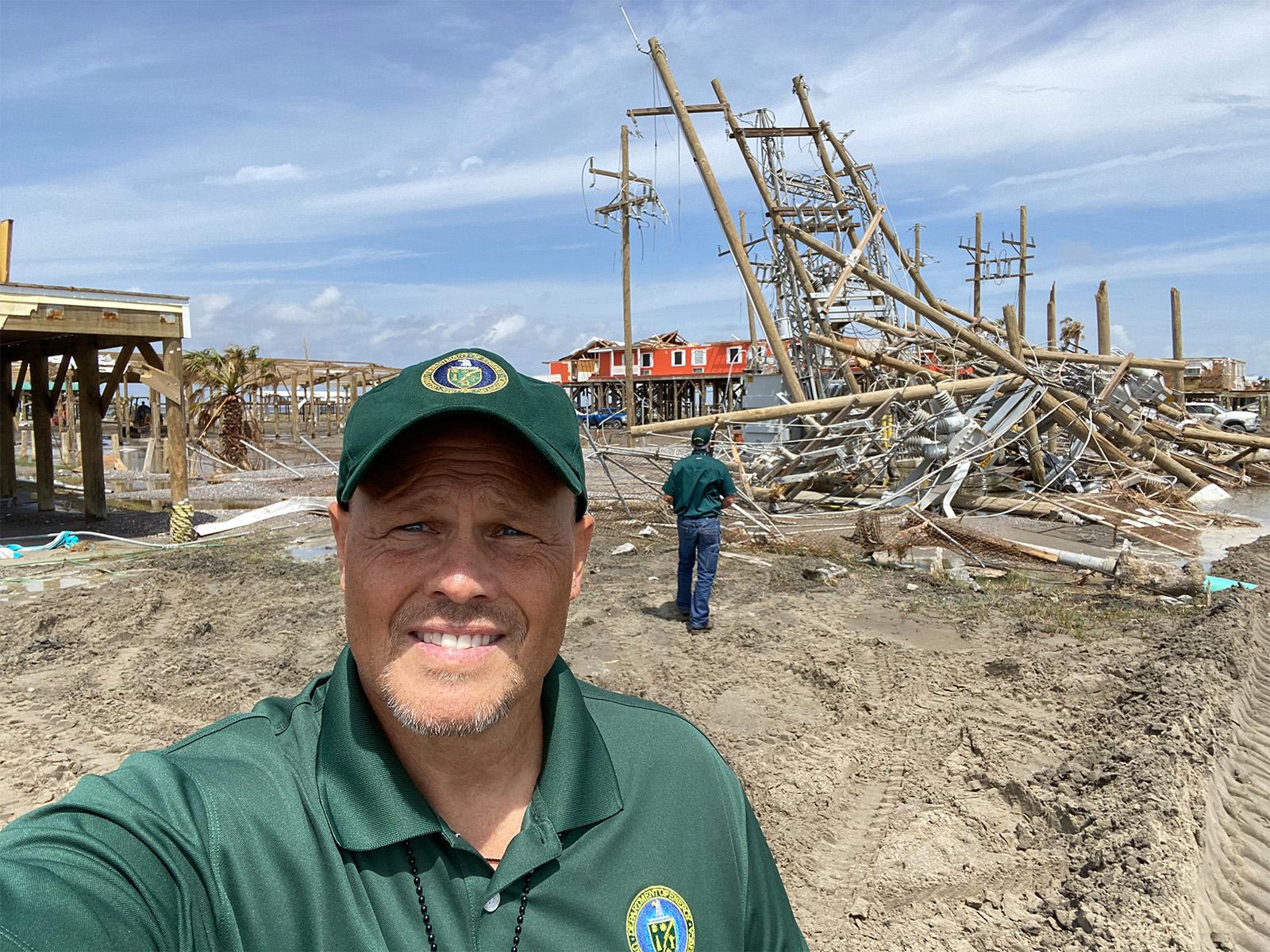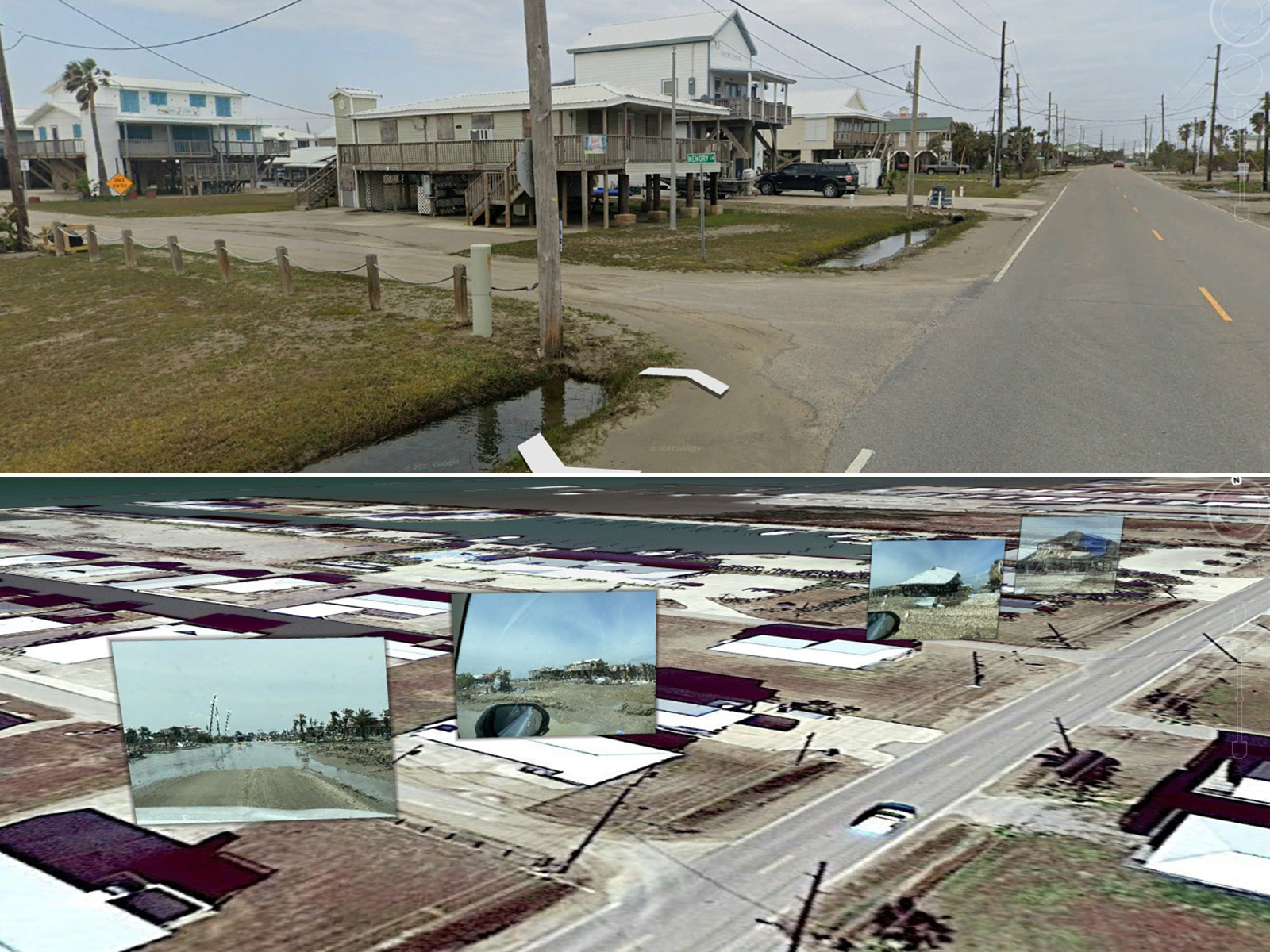Restoring Power When National Disasters Strike
Russ Haffner plays a key role in helping areas get back to normal after an emergency event

Russ Haffner performed damage assessments of the areas affected by Hurricane Ida.
(Photo by Russ Haffner | Pacific Northwest National Laboratory)
As Hurricane Ida was barreling toward the Louisiana coast and cities were being evacuated, Russ Haffner was packing his bag and preparing to head into the heart of the hurricane’s path.
Haffner is a Department of Energy (DOE) Emergency Support Function #12 (ESF#12) emergency responder and serves as one of two DOE ESF#12 regional coordinators for Federal Emergency Management Agency (FEMA) Region 10, which covers Washington, Oregon, Idaho, and Alaska.
This team is activated after a national disaster occurs and when a coordinated federal response is required to assist in the efforts to help victims and communities return to normal after these devastating events.
Emergency support functions
More than 40 years ago, FEMA was created to lead the United States in preparing for, preventing, responding to, and recovering from disasters. Since 2004, FEMA has organized under the U.S. Department of Homeland Security (DHS). In the early 2000s, a National Response Framework was mandated as Homeland Security Presidential Directive Number Five (HSPD-5) and a National Incident Management System (NIMS) was developed by DHS to create a standardized and scalable approach for managing incidents regardless of size and complexity. The National Response Framework structure and NIMS components mesh together, enabling disasters to be systematically managed from smaller local organizations to larger federal ones and across numerous disciplines and infrastructure sectors, from planning to response and recovery.
Using this framework for managing disasters, FEMA has developed 15 ESFs. These ESFs provide support, resources, program implementation, and services that are needed to save lives, protect property, and restore essential services and critical infrastructures. One of these is ESF#12, and its role is to help bring power back after a disaster. This group is made of trained responders with energy system expertise, strong networking capabilities, and excellent information management skills.
Throughout its path of destruction in Louisiana, Hurricane Ida left more than a million people in total with no electrical power. And that’s when the response efforts of ESF#12 were activated. The team comes in to provide assessments of the damaged infrastructure and provides energy sector expertise to FEMA and other federal, state, tribal, and local agencies to assist in power restoration coordination and the flow of critical information to the right stakeholders.
“For example, we had power lines that fell over railroad tracks,” said Haffner. “We needed to move these quickly because they needed to evacuate the area and move assets using rail. We worked with the U.S. Department of Transportation and the U.S. Army Corps of Engineers, which often does the debris removal. So, we’ll work with multiple agencies to try and figure out what and where the problem is, and how to resolve it in a timely fashion in a safe manner.”
Hurricane Ida response
A hurricane is considered a notice event. This means that they can be seen coming, unlike an earthquake, for example, that can just hit without warning.
“FEMA saw that Ida was coming, anticipated where the impact would be, and that this would affect a lot of people,” said Haffner. “All the ESFs were activated, and all the support functions started heading toward the area.”
DOE had ESF#12 leadership in Washington, D.C., and regional response coordination in Texas, while Haffner and a team of ESF#12 responders were deployed to the State Emergency Operations Center and FEMA’s Joint Field Office in Baton Rouge, Louisiana, to help repair and restore power to the region. Ida knocked out eight of the major electrical transmission lines into New Orleans, which meant that there was no way to get power into the city.
“In situations like this, our team does two main things,” said Haffner. “One is to provide subject matter expertise to the energy sector stakeholders like utilities, state emergency organizations, FEMA, and other federal agencies.”
The second role is to provide timely and accurate information flow to all relevant stakeholders. Haffner is responsible for gathering information and moving it in a timely manner to the correct people to get the proper resources to the right locations to resolve power issues.
A new way of capturing damage assessment data
One of the other major roles that Haffner plays within the response organization is helping perform damage assessments of the affected areas. The way he gathers this information is by traveling throughout the different communities and taking photos of the damage—lots and lots of photos.
“When you perform damage assessments, you can take hundreds or thousands of photos in the field,” said Haffner. “With this process you mark where each photo was taken and then categorize it. But one of the challenges is you take so many photos and then you look at them after, and even with the best notes, still ask yourself 'wait, where was the exact location of that one taken?' I knew there had to be a better way.”
Combining his on-the-ground experiences with those at Pacific Northwest National Laboratory, Haffner developed a solution that involved taking the time and location data from the photos he took and overlaying them on Google Earth.
This allowed him to then apply additional layers to the map such as the path of the hurricane, track where the utilities are located, and break the area down by parishes.
“All this data is critical when assessing the damage, and now we can see it all in one location,” said Haffner. “Also, using the street view the team is able to view what the area looked like before the hurricane and then using the overlayed photos, you’re able to see what it looks like now.”
DOE, other response agencies, and utility partners can use this data to strategically determine the next assessment focus areas, help validate impacts to electrical infrastructure and restoration prioritization, enable the identification of potential resilience opportunities, and improve damage assessment analysis and reporting products.

A career of helping
Haffner’s first experience with this work came on a trip to Washington, D.C., when he met two people who were in charge of the ESF#12 Program.
“They told me all about the work and how we go in and get the power back on to help communities,” said Haffner. “I knew I wanted to be a part of that effort, and it really has been great. I get to combine my desire to help people with my desire to be creative and innovative with new tools and techniques.”
He is now in his tenth year of performing this work. And while the hours are long, oftentimes 12-to-16-hour days, and the stress is high, Haffner finds the work rewarding.
“I’m very fortunate to not know what it’s like to have to start over without anything,” said Haffner. “I go to these places after a disaster and I see these people and how they’ve lost everything. This work makes me feel like I’m helping to make a difference in people’s lives the best way I can. And hopefully, through our efforts they’ll be impacted less should this type of event happen again.”
Published: October 20, 2021